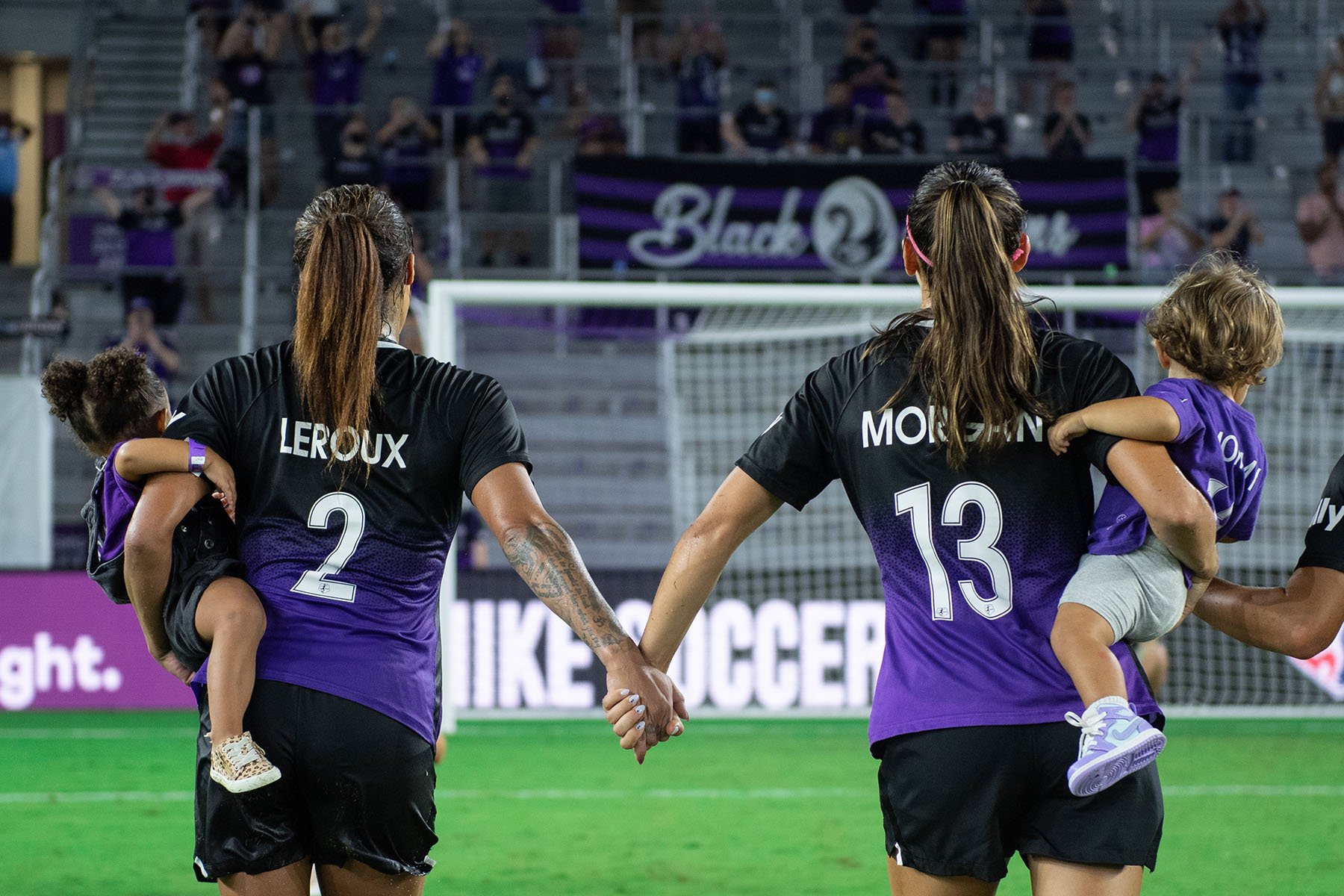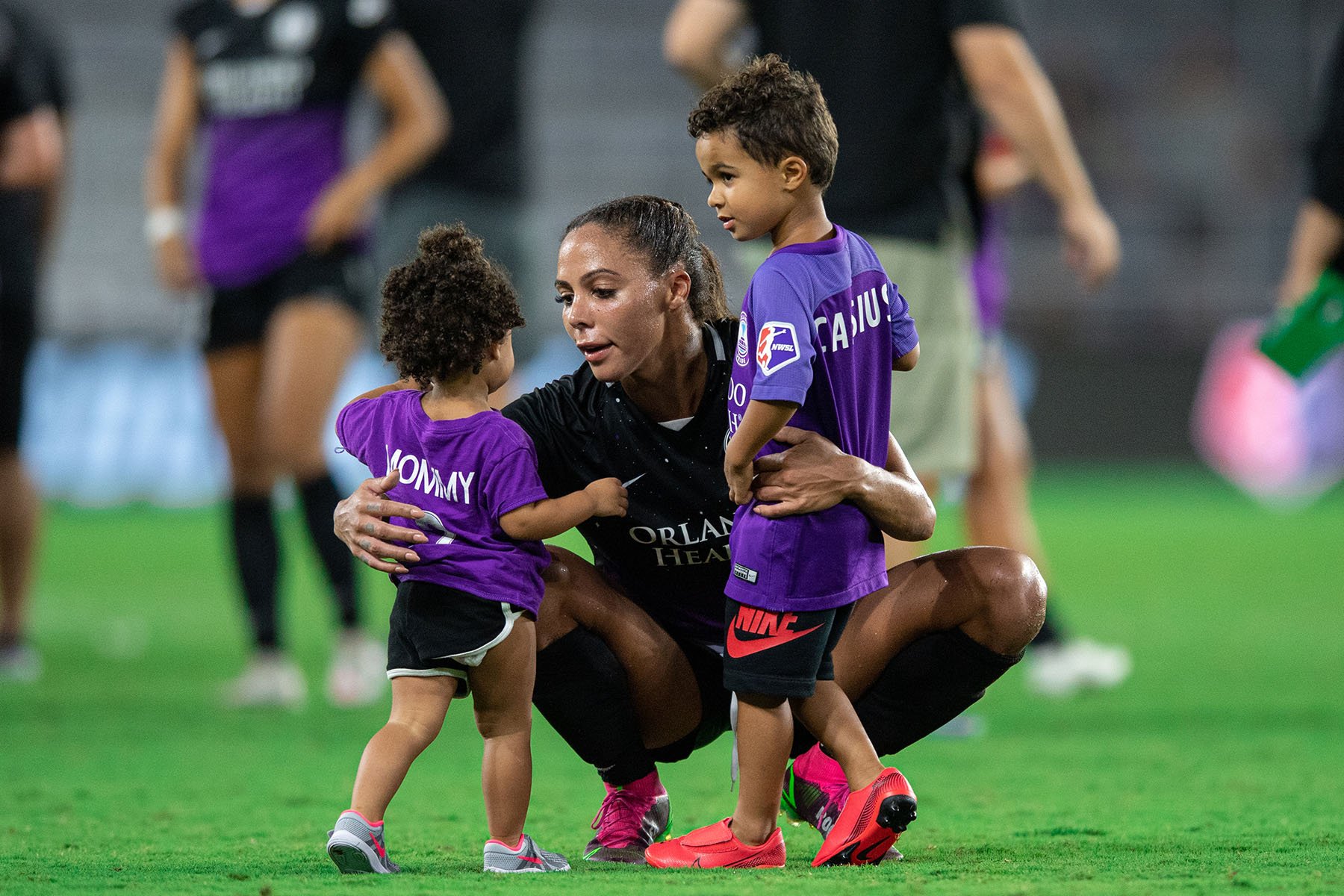Your trusted source for contextualizing the news. Sign up for our daily newsletter.
Earlier this month, the National Women’s Soccer League (NWSL) issued its largest sanction ever against a team, thrusting child care in the league into the spotlight.
On October 3, the league issued a statement that it was fining Los Angeles team Angel City FC $200,000 and docked three points from the team’s standings, a move that ensures it’s all but out of playoff contention. The league determined that the team had surpassed its $2.75 million salary cap — the maximum it can spend on player salaries annually — by $50,000 over four weeks in 2024 through secret deals with players. Team President and CEO Julie Uhrman and General Manager Angela Hucles Mangano were also suspended from any duties related to player transactions for the remainder of the year.
According to the league’s investigation, Angel City had signed five undisclosed side deals with players that exceeded the cap. Which players had signed secret letters and the exact details in them have not been disclosed. But this week, Angel City put out a statement indicating that at least some of the discrepancy was due to payments for child care.
“Our understanding, based on the League’s Salary Cap Rules, was that childcare payments do not count against the salary cap,” the team said in a statement released Monday, adding that it formally requested the league reconsider the three-point deduction. Two Angel City players, Sydney Leroux and Sarah Gorden, have young children.
For years, American women soccer players have been at the forefront of advocating for pay equity in a sport they dominate at a global level. But child care has long been an issue they’ve also contended with, struggling with schedules that whisk them across the country throughout the eight-month season. Some have argued that their pay and benefits simply were not enough to cover child care costs.
According to the NWSL’s 2023 competition manual, players currently get up to $5,000 each annually to cover dependent care, which is the maximum amount set by the Internal Revenue Service and includes flights and hotel rooms for children and child care providers to attend away matches. That amount is fixed regardless of how many children they have and does not count against the salary cap, but any sum over $5,000 does.
A league source told The 19th that child care payments were only part of the reason Angel City was over the cap and got sanctioned. Only one of the five side letters addressed additional child care payments; the rest of that side letter and the other four letters were for additional amounts covering other terms.
Teams negotiate salaries with players, but the players are employees of the NWSL, which handles all salary payments. The side letters are not permitted, and the league only learned about them because an Angel City player was traded to another team and asked whether there were benefits outside of the salary cap agreement.
“There should not be circumstances where players are under an agreement with a club without the league, not only just knowing about it, but being a party to it,” league commissioner Jessica Berman told The Athletic.
That structure, which is similar in the men’s league, is supposed to ensure parity, giving all teams access to the top players — one team can’t pay more to attract top talent. But a recent anonymous survey of the league’s 14 general managers found that several believe teams are regularly breaking the salary cap to gain a competitive advantage.
“We’ve traded for players before and as part of the trade we’ve been informed that they are getting paid other money outside of what’s in their contract, so that’s an indication that other teams are doing it,” one general manager said.
The league has indicated it will now be conducting annual investigations and audits into player spending.
Angel City said in its statement that it acknowledges the mistakes it made and takes “full accountability.”

The situation, however, has shined a light on whether any child care payments should count against the salary cap. The team told The 19th that they are planning to work with the NWSL on the issue and are confident the league wants to work with them.
“We will continue to work towards more equitable solutions to support our players’ childcare needs,” the team wrote in its statement. “Childcare support is fundamental in advancing the professionalization of women’s sports and ensuring that our players feel valued and supported as both professionals and parents.”
The sanctions are coming before the league moves to a new historic collective bargaining agreement with its player union, much of which will go into effect in 2025. It is considered among the most pro-labor agreements in women’s sports.
The new contract eliminates the draft — players will negotiate directly with teams for a spot — and requires player consent for all trades. It increases the teams’ base salary cap from $3.3 million in 2025 to $5.1 million in 2030 and nearly doubles minimum pay for players from $48,500 in 2025 to $82,500 in 2030. There will be no limit on an individual player’s maximum salary. And, critically, parental leave and child care benefits will get a boost.
Meghann Burke, the executive director of the National Women’s Soccer League Players Association, told The 19th that players will get to choose a stipend for dependent care that is up to two times the IRS maximum, bringing it up to $10,000 a season, or they can have child care providers and children under 5 travel at the team’s expense for domestic NWSL-related work.
The situation has also raised questions about whether player salaries are enough to cover child care, something players have been bringing up for years.
In 2020, before the league signed the current collective bargaining agreement that increased minimum pay and introduced a salary cap, Leroux said she paid more money for babysitters and nannies for her children than she earned playing for the Orlando Pride.
She said athletes could not “survive” on a National Women’s Soccer League salary alone, which maxed out at $50,000 then. In 2024, the max salary provision was eliminated and several players signed multi-year deals upwards of $2 million. Sophia Smith, the Portland Thorns forward, has the highest annual deal at more than $500,000. Average player pay is reportedly around $65,000 a year. And while several players earn more through brand endorsements, they still earn far less than male players. The highest earning women’s soccer players earn around $7 million thanks to those deals, while the highest grossing man, Lionel Messi, earns $20 million — and that’s just compensation without counting sponsorship deals.
“Far too often we see women having to make a choice between motherhood and their career. It would be very sad to lose out on the talent we have because they feel like they can’t do both,” Leroux said at the time.
The WNBA has a similar child care provision in its current collective bargaining agreement, offering a $5,000 stipend. Players are hoping to increase that amount in their next contract.
This issue doesn’t show up in men’s sports, where often partners are the ones taking care of children, said Alicia Jessop, an industry expert who founded the sports business website RulingSports.com.
“Women have traditionally been the child care provider, and when you have a job that takes you on the road multiple months out of the year, someone’s got to take care of the child, and the way that these leagues are currently structured doesn’t provide meaningful child care,” Jessop said.
The case with Angel City opens up the question, Jessop said, of whether the league should further bolster what can be offered outside the salary cap for child care so that players who are parents aren’t at a disadvantage.
The cost of child care in the United States has risen at nearly twice the pace of inflation over the past 30 years, now surpassing the cost of in-state college tuition in more than 30 states. On average, it costs about $11,600 a year; in California it costs nearly $20,000 annually on average for center-based care.
Part of the reason child care is such a challenge in the United States is because it is not federally subsidized at the rate it is in other nations. The U.S. federal government helps to lower the cost of care for very low-income families, but the system as a whole is not subsidized, meaning many parents are spending more than their rent or mortgage on care. The United States also does not have a federal paid leave policy for parents, a distinction it shares with only six small nations.
That is relevant where women’s soccer is concerned, because the caliber of U.S. players gives them the option of potentially playing for European teams. The U.S. national women’s soccer team has won a record four World Cup titles and five Olympic gold medals.
European teams do not have a salary cap in place, and those players also enjoy generous parental leave and child care policies in countries that have subsidized care. In Europe, new parents have paid leave of 14 months on average, and several countries, including Germany, France and Denmark, either guarantee children a spot in child care, cover most of the cost, or both.
The American teams are “competing with these European owners, who don’t care whether they make money or not — they’re only interested in winning” and are therefore willing to pay players more, said David Berri, who recently co-authored a book on women’s sports, “Slaying the Trolls! Why the Trolls are Very, Very Wrong About Women and Sports.”
Berri said that though Angel City broke the rules, “I think we should understand why they have to do that.”





